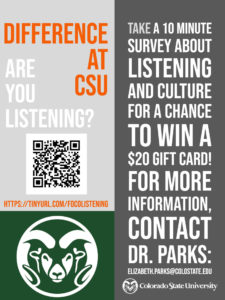Have you ever been accused of “not listening”? Did you feel misunderstood? Have you ever accused someone of poor listening skills because they didn’t engage the way you wanted? Now is your chance to put that misunderstanding to good use by participating in a survey about listening across difference.
Data from the 10-minute survey will inform research conducted by Assistant Professor of Communication Studies Elizabeth Parks. Parks’ research explores how communities of difference in the United States may diverge and overlap in their understanding of what it means to listen well and how that impacts our interpersonal and community relationships.
Her research draws in part on a “listening concepts inventory” developed by communication scholars Margarete Imhof and Laura Ann Janusik. The inventory categorizes listening into four major dimensions: information acquisition, relationship building, learning, and evaluative listening.
 These different approaches to listening reflect listening orientations that are influenced by cultural values and social norms, individual personalities and goals, and situational needs and contextual cues. Individual listening styles tend to draw on more than one dimension although favor a dominant orientation, such as listening to build relationships.
These different approaches to listening reflect listening orientations that are influenced by cultural values and social norms, individual personalities and goals, and situational needs and contextual cues. Individual listening styles tend to draw on more than one dimension although favor a dominant orientation, such as listening to build relationships.
Earlier survey results
In data collected from listening surveys and focus groups conducted in the Pacific Northwest and Upper Midwest, Parks found that study participants within and across these two regions shared commonalities in conceptualizing listening as most closely related to learning and least closely related to evaluative listening, yet there appears to be a difference among ages and generations within and across these regions.
Parks found that members of Latinx communities were more likely to consider behaviors such as arguing, being critical, answering, and conceding (the evaluative or critical learning construct) as more closely related to “good” listening than members of White/Caucasian, First Nation/Native American, and Asian American racial groups. This could result in a White/Caucasian person interpreting the presence of those evaluative communicative behaviors as “poor” listening, while a Latinx person interprets the absence of those same behaviors as “poor” listening instead.
“How we listen to others and our expectations of how others listen to us appears to differ by our racial identification and age,” Parks says. “This has real-life implications that could lead to inter-racial and intergenerational conflict even when all parties genuinely have the intent to listen,” Parks says.
PSD suspensions, expulsions
To illustrate this point, Parks applied survey data from her Pacific Northwest and Minnesota studies to Poudre School District data on student suspensions and expulsions. A 2019 PSD report shows that nearly 73.4% of enrolled students identify as White/Caucasian, while 26.6% identify as a member of another racial group, with Latinx making up 17.9% of the enrolled population.
In contrast, students of color made up more than 50% of students who were suspended, and more than 60% of students who were expelled. Trends show that White/Caucasian students tended to face suspension because of objective things they did, such as cheating, whereas students of color tended to face suspension because of so called “behavioral” issues. These “behavioral” issues might be a direct result of a cultural misunderstanding of how to listen in the classroom.
Parks argues that we need to understand that cultures perform differently when it comes to the values of listening to learn and listening to engage critically, as they have real-life implications for equity and inclusion.
She asks us to consider, “How do we decide when to listen as we think we should, or when to listen as others expect us to?”
CSU students, staff, and faculty, and members of the broader Fort Collins community are encouraged to participate in Parks’ listening survey: https://tinyurl.com/focolistening. Participants who complete the survey have a chance to be a random winner of one of 10 $20 Amazon gift cards.
This story originally appeared in CLA Source.